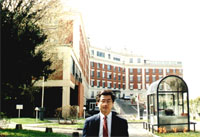 |
|
![]() American Hospital of Paris (5)
American Hospital of Paris (5) ![]()
Difficulties as the first Japanese physician in Paris
(2)
 I started
practicing in May 1995. I could not practice full time, because I shared
the consultation room with an American doctor. For the first few months
I was seeing only several patients a day, so there was no problem with
room sharing. I set the consultation fee as 500 francs equivalent to
10,000 yen then. It was a little bit expensive by Japanese standards.
However, medical expenses of business people and their families were
paid by their companies, and those of students and travelers were 100%
covered by the travellers’ insurance. Therefore, the fee didn't matter
at all as far as Japanese patients were concerned. The consultation
was by appointment and I reserved 30 minutes for a patient.
I started
practicing in May 1995. I could not practice full time, because I shared
the consultation room with an American doctor. For the first few months
I was seeing only several patients a day, so there was no problem with
room sharing. I set the consultation fee as 500 francs equivalent to
10,000 yen then. It was a little bit expensive by Japanese standards.
However, medical expenses of business people and their families were
paid by their companies, and those of students and travelers were 100%
covered by the travellers’ insurance. Therefore, the fee didn't matter
at all as far as Japanese patients were concerned. The consultation
was by appointment and I reserved 30 minutes for a patient.
90% of the patients were Japanese, with whom there was no problem at
all. Asian patients who wanted the consultation in English came to see
me sometimes, with whom I also dealt very well. Although very few, there
were some French patients without the knowledge of English who wanted
to see me. Some wanted to use Japanese immunotherapy agents, Maruyama
vaccine or Hasumi vaccine for cancer. Others just wanted Japanese style
consultation in French. Those patients didn't want fluent French in
consultation in any case, so there was no significant problem.
I had difficulties in dealing with a patient who developed psychiatric
symptoms, even though the patient was Japanese. Paris has often been
a famous city for Japanese travelers to develop psychiatric symptoms.
It is called “Paris syndrome” and was detailed in a best seller documentary
in the mid 1980s by Japanese psychiatrist, Dr. OHTA. I consulted several
times to Dr. OHTA in those cases. On those occasions I thought that
psychiatric problems could be managed only by a psychiatrist of the
same culture.
One of the nuisances during consultation were the telephone inquiries
from the pharmacy. All medications are given by prescription in France.
Since my way of prescription was not usual, in the beginning, there
were a lot of inquiries. I had to answer them in French, so I was a
little bit nervous. I managed to do it by remembering the name of trade
names of the medicines and their doses. Some of the pharmacists spoke
aggressively to me in very rapid French on purpose. In those occasions,
the best I could do was to say coldly, “I don't understand what you
mean at all, ” as was suggested by the authority of Hopital Americain.
They slowed down their French most of the time after I said this. The
worst response was to apologize for my inappropriate French.
Even though I was working in a well known hospital, I could not just
expect patients to come in for a consultation by just waiting. I tried
to make business efforts to increase the amount of patients. I sent
letters notifying the opening of my practice at AHP to most of the Japanese
companies in Paris before my arrival. The number of patients increased
remarkably. The average number of patients I saw became more than 10
per day. In the end I saw 3000 out-patients and 500 health check-up
clients.
After arriving at Paris, I took part in most of the parties held by
Japanese Embassy and any gatherings of Japanese businessman. Meanwhile,
I was asked to speak at the meeting of Japanese Chamber of Commerce
of Paris or invited as a guest speaker to the Japanese radio talk show.
The number of patients gradually increased as the result of those efforts.
Then I needed my own consultation room, which I got through repeated
negotiations with CEO of the hospital.
As I explained, I was self-employed at AHP. Therefore I had to take
care of everything concerning my practice including taxes. Since I didn't
have any experience starting a private practice even in Japan, I felt
somewhat uneasy. I was introduced to an accountant by a Japanese banker.
Since I started the practice as the first Japanese physician with some
risk, I didn't have to pay rent for the consultation room and the salary
of the secretary. The accountant told me to increase the tax-deductible
expenditures. He gave me a lot of specific advice. For example, he told
me not to buy a car, and to use taxi instead. If I wanted to use a car
for a vacation, I was told to rent a car. If I had any medical or business
reasons for the travel, part of the expenditure could be tax-deductible.
I could eat out up to twice a week for business, but I had to write
down the reason on the receipt. These are just some ways to save on
taxes. After experiencing private practice in Paris for 2 1/2 years,
it became second nature to get receipts whenever I bought something
and to keep records with some comments.
| BACK |
E-mail:kidot@momo.so-net.ne.jp